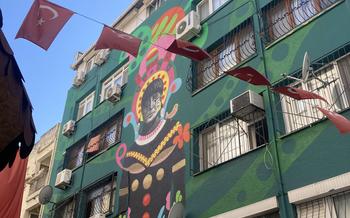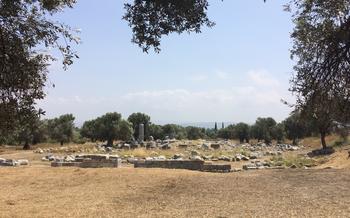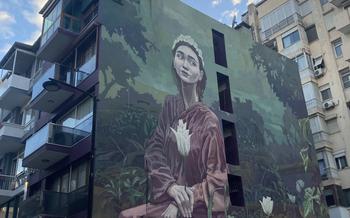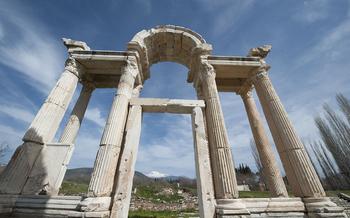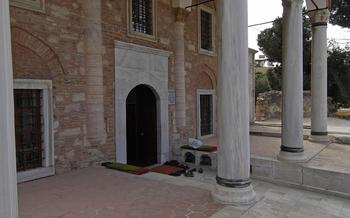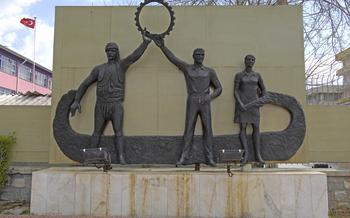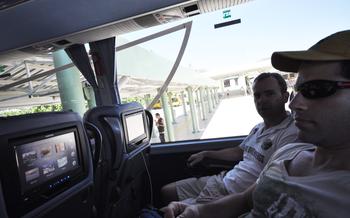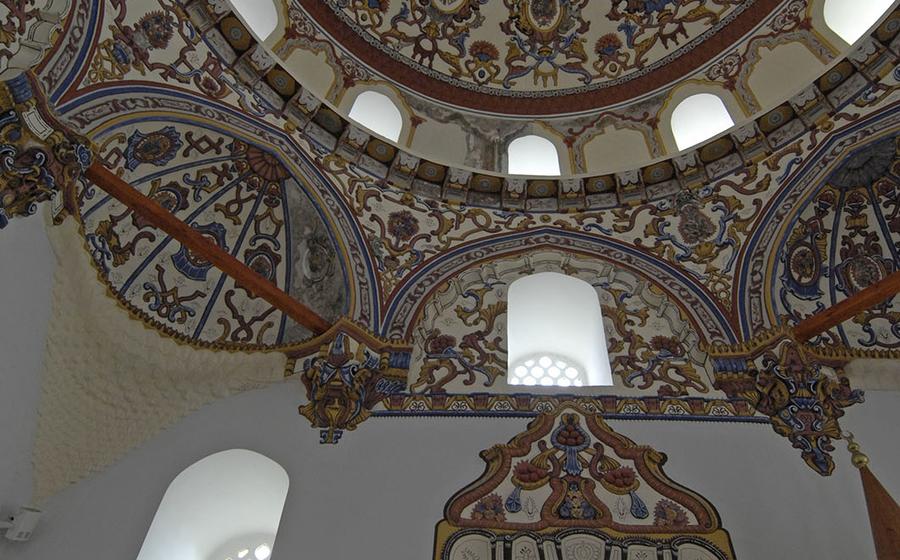
Priene Ancient City
- Historical Background
- Architectural Wonders
- Urban Planning and Infrastructure
- Theatre of Priene
- Necropolis and Tombs
- Museum of Priene
- Getting There
- Entrance Fees and Hours of Operation:
- Guided Tours
- What to Wear and Pack
- Photography Tips
- Local Cuisine
- Accommodation Options
- Things to Do Nearby
- Insider Tip
Historical Background
Priene, a city of ancient Ionia, was founded in the 11th century BC by Greek colonists from Miletus. Strategically located on a hill overlooking the fertile valley of the Meander River, Priene quickly rose to prominence as a trading and cultural center. It joined the Ionian League, a powerful confederation of twelve Ionian cities, and played a significant role in shaping the political and cultural landscape of the region.
Priene's golden age came during the Hellenistic period (323-146 BC) when it flourished under the rule of Alexander the Great and his successors. The city became a center of learning and culture, attracting philosophers, artists, and scholars from across the Mediterranean. Notable figures associated with Priene include the philosopher Bias, one of the Seven Sages of Greece, and the historian Hecataeus. Priene's contributions to science, philosophy, and literature earned it a reputation as a cultural and intellectual hub of the ancient world.
Architectural Wonders
Priene's architectural legacy is a testament to the city's ingenuity and artistry. The city walls and gates, constructed with massive stone blocks, stand as a testament to the city's defensive capabilities. These walls once encircled the entire city, providing protection from invaders and securing its inhabitants.
The Temple of Athena Polias, dedicated to the patron goddess of the city, is an architectural masterpiece. Built in the Ionic style, the temple features a grand facade with six fluted columns supporting an elaborate pediment. Inside, the temple was adorned with intricate sculptures and reliefs depicting scenes from Greek mythology.
The Bouleuterion, or council chamber, is a unique and well-preserved structure. With a capacity to accommodate over 600 citizens, it served as the meeting place for the city's governing body. The Bouleuterion's distinctive horseshoe-shaped design provided excellent acoustics, ensuring that all participants could be heard clearly during debates and discussions.
The Agora, or marketplace, was the bustling center of commercial activity in Priene. Surrounded by shops, stalls, and public buildings, the Agora served as a meeting place for traders, merchants, and citizens alike. It was here that the city's economic and social life flourished.
These architectural wonders, each with its own unique features and significance, showcase the remarkable achievements of Priene's ancient builders and stand as a testament to the city's cultural and intellectual prowess.
Urban Planning and Infrastructure
Priene is renowned for its sophisticated urban planning and infrastructure, which showcase the advanced engineering and architectural skills of its ancient inhabitants. The city features a grid-like layout, with streets intersecting at right angles, reflecting the influence of Hippodamus of Miletus, a renowned urban planner of the time. This grid system ensured efficient movement throughout the city and provided a model for urban planning that would be adopted by many other ancient cities.
Priene's water management system was also highly advanced. The city had an extensive network of aqueducts and underground channels that brought fresh water from nearby springs to public fountains and private homes. This system ensured a reliable water supply for the city's inhabitants and contributed to their health and well-being.
Moreover, Priene had a sophisticated drainage system that effectively managed rainwater and wastewater. The streets were sloped to allow water to drain into underground channels, which then directed it outside the city walls. This system prevented flooding and helped maintain the city's cleanliness and sanitation.
The roads and streets of Priene were carefully designed and constructed, using large stone blocks or cobblestones. These roads facilitated transportation and trade within the city and connected it to other settlements in the region. The well-maintained roads also enhanced the city's overall appearance and contributed to its reputation as a prosperous and well-organized city.
Theatre of Priene
Amidst the ruins of Priene, the ancient theatre stands as a testament to the city's cultural and artistic achievements. With its impressive size and capacity of over 5,000 spectators, this theatre was once the center of entertainment and civic life in Priene. Its well-preserved stage building, adorned with intricate carvings and sculptures, reflects the city's refined taste and craftsmanship.
The theatre's exceptional acoustics and sightlines allowed every member of the audience to fully immerse themselves in the performances. From tragedies and comedies to musical concerts and political debates, the theatre hosted a wide range of events that shaped the cultural fabric of ancient Priene.
Its unique architectural features, including a curved seating arrangement and a sophisticated drainage system, demonstrate the advanced engineering skills of the city's architects. The theatre's impressive dimensions and grandeur continue to captivate visitors, offering a glimpse into the vibrant cultural and social life of this ancient Ionian city.
Necropolis and Tombs
Among the ruins of Priene, the necropolis, or cemetery, holds a significant place. It lies to the east of the ancient city, offering a glimpse into the burial practices and customs of the Prienians. The necropolis features a variety of tombs, each unique in design and construction.
Rock-cut tombs are a prominent feature of the Priene necropolis. These tombs are carved directly into the soft rock of the surrounding hills. They typically have a simple rectangular shape with a gabled roof. Some rock-cut tombs are more elaborate, featuring multiple chambers and decorative elements.
Notable individuals, such as wealthy citizens and government officials, were often buried in elaborate tombs. These tombs are typically larger and more ornate than the standard rock-cut tombs. They may feature intricate carvings, sculptures, and inscriptions honoring the deceased.
The artistic and architectural elements of the tombs in the Priene necropolis are also noteworthy. Many tombs are decorated with reliefs, frescoes, and mosaics depicting scenes from mythology, daily life, and religious rituals. These decorations provide valuable insights into the beliefs and values of the ancient Prienians.
Museum of Priene
Located within the ancient city, the Museum of Priene houses a collection of artifacts that provide valuable insights into the history and culture of this once-thriving metropolis. The museum's exhibits include sculptures, pottery, inscriptions, and other objects unearthed during excavations at the site. Visitors can admire intricate marble sculptures depicting gods, goddesses, and historical figures, as well as well-preserved pottery vessels, coins, and jewelry. The museum also houses a collection of inscriptions that shed light on the city's administration, laws, and religious practices. These artifacts offer a tangible connection to the daily lives of the people who inhabited Priene centuries ago, making the museum a must-visit for anyone interested in understanding the rich cultural heritage of this ancient city. Interactive displays and educational programs further enhance the visitor experience, making the Museum of Priene an essential stop on any journey through this remarkable archaeological site.
Getting There
Reaching Priene is a breeze, with several transportation options available from major cities in Turkey. From Izmir, the closest major city, you can hop on a bus that will take you directly to the ancient city in about 2 hours. If you're coming from Istanbul, you'll need to take a flight to Izmir and then transfer to a bus or taxi for the remaining journey. The drive from Izmir to Priene is approximately 120 kilometers, and the trip takes around 2 hours.
Insider Tip: Catch an early bus from Izmir to avoid the midday heat and maximize your exploration time at Priene.
Entrance Fees and Hours of Operation:
Visiting Priene and its museum offers an immersive journey into the past, but it's essential to plan your trip by considering the entrance fees and hours of operation. The ancient city and the museum have separate ticket prices, allowing visitors to choose their preferred experience. For the ancient city, expect to pay a reasonable entrance fee that contributes to the preservation and maintenance of this historical site. The museum, housing a collection of artifacts and exhibits, also has a separate entrance fee.
Operating hours for both attractions are crucial for planning your visit. The ancient city and the museum typically follow similar schedules, opening daily except for Mondays. During the summer months, extended hours may be in effect to accommodate the influx of visitors. Check official sources or inquire locally for the most up-to-date information on operating hours to ensure a smooth and enjoyable visit to Priene.
Keep an eye out for any discounts or free admission options that may be available. Students, senior citizens, and holders of certain cultural heritage cards often receive reduced rates or free entry. Take advantage of these concessions if applicable to save on your entrance fees.
Finally, consider the best time to visit Priene to avoid crowds and fully appreciate the grandeur of the ancient city. Early mornings or late afternoons, when the sun is less intense, offer ideal conditions for exploration and photography. Visiting during the shoulder seasons (spring or fall) can also provide a more tranquil experience with fewer tourists.
Guided Tours
Exploring Priene with a knowledgeable guide can greatly enhance your understanding and appreciation of the ancient city. Guided tours are available in various languages and offer a range of options to suit different interests and budgets.
Group tours are a popular choice for budget-conscious travelers. These tours typically include a visit to the main attractions, such as the Temple of Athena Polias, the Bouleuterion, and the theatre, and provide historical context and insights.
For a more personalized experience, consider booking a private tour. Private tours allow you to customize the itinerary based on your specific interests, whether it's architecture, history, or photography. You'll have the undivided attention of your guide, who can answer your questions and provide in-depth explanations.
Audio guides are another option for self-guided exploration. These guides offer recorded commentary and information about the various sites, allowing you to learn at your own pace. Audio guides are available in multiple languages and can be rented at the ticket office.
When choosing a guided tour, consider the following factors:
- Group Size: Smaller groups tend to offer a more intimate and interactive experience.
- Language: Ensure that the tour is offered in a language you understand.
- Duration: Tours can range from a few hours to full-day excursions. Choose a tour that fits your schedule and interests.
- Cost: Prices vary depending on the type of tour, group size, and duration.
With a guided tour, you'll gain a deeper understanding of Priene's rich history and cultural significance, making your visit even more memorable.
What to Wear and Pack
When preparing for your trip to Priene, it is essential to prioritize comfort and practicality. Comfortable clothing and sturdy footwear are crucial for navigating the uneven surfaces and cobblestone paths of the ancient city. Opt for lightweight, breathable materials that will keep you cool and comfortable under the Turkish sun. A hat, sunglasses, and sunscreen are essential for protection against the intense UV rays.
Pack a camera to capture the stunning views and historical sites. A tripod will ensure stability and help you avoid blurry shots. Bring plenty of water and snacks, as food options are limited on-site. Consider bringing a flashlight or headlamp if you plan to explore the underground tunnels and chambers. Remember, the ancient city is a historical site, so avoid touching or damaging the ruins.
Photography Tips
Capturing the essence and beauty of Priene through photography is an unforgettable experience. To make the most of your photographic journey, consider the following tips:
-
Golden Hour Magic: Plan your visit during the golden hours, around sunrise or sunset, when the soft, warm light casts a magical glow on the ancient ruins. This time of day offers the most favorable lighting conditions for stunning photographs.
-
Exploring Perspectives: Experiment with different angles and vantage points to create unique and captivating compositions. Climb to higher ground for panoramic shots or get up close to capture intricate details of the architecture.
-
Tripod Stability: Utilize a sturdy tripod to ensure stability and avoid camera shake, especially when shooting in low-light conditions or capturing long exposures. This will help you achieve sharp and clear images.
-
Creative Storytelling: Look for unique angles and perspectives that tell a story. Capture the interaction of light and shadow, frame elements within the frame, and include people or objects to add a sense of scale and human connection.
Local Cuisine
Savor the Delights of Traditional Turkish Cuisine
Immerse yourself in the vibrant culinary scene of Turkey by tasting the delectable dishes that define the region. Venture beyond the ancient ruins of Priene and explore the nearby towns and villages, where you'll find an array of restaurants serving up authentic Turkish fare. Indulge in the tantalizing flavors of kebabs, expertly grilled skewers of succulent meat, and pide, a traditional flatbread topped with a variety of savory fillings. Don't miss the opportunity to sample meze platters, a delightful assortment of small dishes that showcase the diverse flavors of Turkish cuisine.
Must-Try Dishes for an Unforgettable Culinary Experience
Whet your appetite with some of the must-try dishes that have earned Turkish cuisine its reputation for excellence. Begin your culinary journey with yaprak sarma, tender grape leaves stuffed with a flavorful blend of rice, herbs, and spices. Savor the richness of güveç, a hearty stew prepared with slow-cooked lamb or beef, vegetables, and aromatic spices. For a taste of the sea, indulge in balık ekmek, a simple yet delicious grilled fish sandwich that captures the essence of Turkish coastal cuisine.
Explore Local Markets for Fresh Produce and Culinary Treasures
Discover the vibrant colors and aromas of local markets, where vendors display an array of fresh produce, spices, and sweets that are sure to tantalize your taste buds. Immerse yourself in the lively atmosphere as you browse through stalls overflowing with ripe fruits, crisp vegetables, and fragrant herbs. Sample the local honey, known for its distinct floral notes, and savor the sweetness of freshly baked pastries that will transport you back in time.
Vegetarian and Vegan Delights for Every Palate
Even if you follow a vegetarian or vegan diet, you'll find plenty of delicious options to satisfy your cravings in the region surrounding Priene. Explore the rich world of Turkish meze, where you'll find an array of plant-based dishes that burst with flavor. Indulge in hummus, a creamy dip made from chickpeas, tahini, and lemon juice, and enjoy the tangy freshness of cacık, a yogurt-based sauce with cucumber and garlic. Don't forget to try mercimek çorbası, a hearty lentil soup that is both nutritious and comforting.
Accommodation Options
When seeking accommodation near Priene, several towns and villages offer a range of options to suit different budgets and preferences. One charming option is the town of Söke, located approximately 20 kilometers from the ancient city. Söke offers a delightful blend of modern amenities and traditional Turkish charm, with a variety of hotels, guesthouses, and Airbnb listings to choose from.
For a truly immersive experience, consider staying in a traditional Turkish house or a boutique hotel. These accommodations often feature unique architectural elements, intricate designs, and warm hospitality. They provide an opportunity to connect with the local culture and gain a deeper appreciation for Turkish traditions.
For those seeking a more luxurious stay, several upscale hotels are located in the nearby coastal towns of Kuşadası and Didim. These hotels offer stunning sea views, modern amenities, and easy access to the region's pristine beaches.
No matter your budget or preferences, there are plenty of accommodation options near Priene to ensure a comfortable and enjoyable stay. Take the time to research and choose the one that best suits your needs and interests.
Things to Do Nearby
After exploring the wonders of Priene, venture beyond its borders to discover neighboring treasures. Journey to the ancient cities of Ephesus, Miletus, and Didyma, each boasting its own unique charm and historical significance. Immerse yourself in the beauty of the Aegean Sea, where pristine beaches and picturesque coastal towns await your arrival. Embrace nature's splendor at nearby national parks, where verdant landscapes, enchanting caves, and cascading waterfalls offer a refreshing escape. Stay tuned for local festivals, events, and activities that showcase the vibrant culture and traditions of the region, ensuring an unforgettable and enriching travel experience.
Insider Tip
For a more fulfilling and memorable experience, consider these insider tips:
-
Visit Priene during the shoulder season (spring or fall) to escape the scorching summer heat and the influx of tourists. The weather is pleasant, and you'll have the ruins largely to yourself, allowing for a more intimate and immersive exploration.
-
Bring a flashlight or headlamp to venture into the subterranean tunnels and chambers. These hidden passageways offer a unique perspective of the city's ancient infrastructure and provide an exciting element of discovery.
-
Guided tours specifically designed for photography enthusiasts are available. These tours are led by experienced photographers who can guide you to the best vantage points, provide technical advice, and help you capture stunning images of the ruins.
-
Remember that Priene is a historical site of great significance. Please respect the ruins by refraining from touching or damaging them. Your actions can help preserve this ancient city for generations to come.
